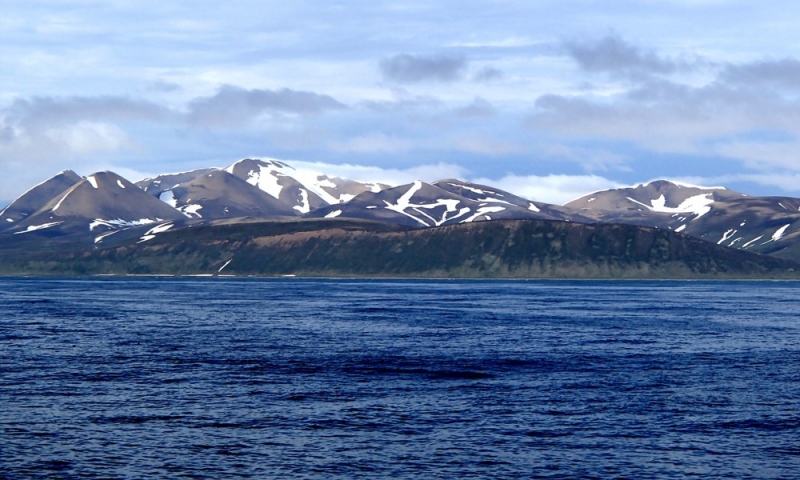
Ecotourism is a new, but already popular travel format in Russia. From ordinary walks in the forest or trekking, it involves visiting places almost untouched by human influence. Eco-trails are often laid through nature reserves or reserves – routes that allow you to get acquainted with natural objects and ecosystems, which often pass through man-made historical and cultural objects. We talk about the most interesting ones in our material.
Sarykum dunes: “The path of the wise turtle”

Sarykum, which means “yellow sand” in Kumyk, is the hottest place in Dagestan: in summer the surface temperature of the dunes warms up to 55-60 °C. It covers an area of 600 hectares and reaches a height of 262 m, being the largest dune not only in Russia, but throughout Eurasia. It is believed that Sarykum is a fragment of Asian deserts, surrounded by steppes, and its age is estimated at several hundred thousand years.
The desert is home to many unusual animals and plants, which is why Sarykum is protected. Tourists can visit it by walking along the Wise Turtle Trail. A controlled route will protect you from unpleasant encounters with scorpions and snakes and will prevent you from unknowingly harming a unique ecosystem. The trail offers impressive views of the Caspian Sea, the Kapchugai Gorge and the Shura-Ozen River, which divides the nature reserve in two. By the way, the name of the trail was not chosen by chance: the Mediterranean turtle, which can usually be seen on the beaches of southern Europe, has perfectly settled in the Caspian sands. Her neighbors were the griffon vulture, the bushy jerboa, the antlion, the scarab, the brown hare and other animals.
Where to stay in Dagestan:
- In the apartments “Riviera Caspian” in Kaspiysk (rating 9.8) – from 2,400 rubles per day*.
- In the four-star hotel “Monto” in Makhachkala (score 10) – from 6,900 rubles per night*.
- In the four-star hotel “AZIMUT Kaspiysk” in Kaspiysk (rating 9.5) – from 8,400 rubles per day*.
Commandersky Nature Reserve: eco-trail on Bering Island

Amazing Kamchatka can be visited countless times, with each visit discovering its unique natural diversity from a new side. The Komandorsky Nature Reserve is considered the largest marine biosphere reserve in Russia. The size of its water area is comparable to the area of a small state (for example, Belgium), it includes four large islands (Beringa, Medny, Toporkov and Ariy Kamen), more than 60 small islands and the adjacent waters of the Bering Sea and the Pacific Ocean. The territory of the Commanders is home to many rare and endemic species: Antour seal, Steller sea lion, striped seal, minke whale, sea otter, Commander’s harp-toothed seal, bald eagle, blue arctic fox. It also hosts year-round whale watching.
The eco-trail on Bering Island runs near the north-western rookery of marine mammals: you will be able to observe the animals from a shelter from a relatively close distance, but without direct contact that would disturb the calm course of their life. This trail is constantly expanding, and the reserve staff is happy to give excursions and talk about the characteristics of the local inhabitants.
Kronotsky Nature Reserve: trail along the Valley of Geysers

Another picturesque Kamchatka biosphere reserve is located in the eastern part of the peninsula: local areas have been protected since 1882. It is here that the famous Kamchatka Valley of Geysers, eight active volcanoes (including Kronotskaya Sopka with a height of 3528 m), waterfalls and thermal lakes are located.
The trail passes through one of the largest geyser fields in the world (and the only one on continental Eurasia). Here you can see numerous hot spring outlets. Of course, the flow of tourists to this place is huge, which can significantly harm the entire rare ecosystem. The excursion eco-trail is laid along the central part of the valley, allowing you to examine all known modern forms of hydrothermal activity: hot lakes, pulsating boiling springs, mud pots, steam jets, warm areas and, of course, the geysers themselves, gushing steam.
Where to stay in Kamchatka:
- At the Paratunka hostel in Paratunka (rating 9.9) – from 2,400 rubles per night*.
- In the three-star Aerohotel in Elizovo (score 10) – from 5,000 rubles per night*.
- At the villa “Eco-House Kamchatka” in Termalny (score 9.5) – from 26,400 rubles per day*.
Altai Nature Reserve: underwater eco-trail

Altai Nature Reserve is part of the UNESCO World Heritage Site “Golden Mountains of Altai”. Majestic slopes covered with coniferous forests, rushing waterfalls, unique traditions of the region – all this attracts lovers of hiking and equestrian tourism from year to year.
However, as it turned out, Altai can be explored not only by land. On the territory of the reserve there is Lake Teletskoye, the largest body of water in the region. The first underwater eco-trail in Russia appeared here, which begins in the village of Yailyu. The diving route takes about three hours, during which you can see a sunken wooden dam, a floating weather station, trees and various underwater inhabitants that are under water due to changes in the landscape. Both professional and beginner divers are allowed to dive.
Where to stay in the Altai Territory:
- At the recreation center “Cedar Coast” near Nizhnekayanchi (rating 8.0) – from 2,600 rubles per day*.
- In the Kaimskoye estate in the city of Aya (score 9.0) – from 3,700 rubles per night*.
- At the “Crown of Altai” hotel in Katun (rating 8.6) – from 7,400 rubles per night*.
Sikhote-Alin Nature Reserve: “Mount Lysaya” and “Arsenyevskaya”

One of the Sikhote-Alin ridges in the Far East was once turned into a protected area to preserve and restore the population of the almost exterminated sable. Today it is also an ideal place to observe Amur tigers in their natural habitat. The 1.5 km long eco-trail “Mount Bald” is a complete immersion into the wild nature of the region: here you can find ungulate tracks, tiger scrapes, boar baths, and even see some animals from afar.
Another trail, named after the ethnographer and explorer of the Ussuri region Vladimir Arsenyev, allows you to walk part of the route of the scientist’s expedition. The trail, laid through dense Far Eastern forests, is designed to take several days. Tourists usually spend the night in specially equipped cordon huts, and in each of them there is a book with stories about the original expedition.
Where to stay in Primorsky Krai:
- In the three-star VLcome Inn hotel in Vladivostok (score 10) – from 2,600 rubles per day*.
- In the Holiday Home Soft guest house in Vladivostok (rating 9.9) – from 4,700 rubles per night*.
- At the five-star Tigre de Cristal Resort & Casino in Artyom (score 9.9) – from 6,500 rubles per day*.
Kenozersky National Park: Transkenozero Trail

This reserve is a unique natural and cultural reservation in the southwestern part of the Arkhangelsk region. Today, Kenozerye preserves not only nature, but also the historical human habitat, supporting the original culture of the Russian North. Admire numerous architectural monuments, monumental paintings, iconography, archeology, and also feel like a real ethnographer by visiting villages where crafts and traditions are still revered.
Transkenozerskaya trail is a 36-kilometer walking route, designed for two days and passing along the historical road between Lekshmozero and Kenozero (it was along this path that the ancient Novgorodians of the 12th-14th centuries developed the territories of Kenozero). The route passes through ancient villages, holy groves and worship crosses, as well as the Porzhensky churchyard, which is called the local Kitezh-grad.
Where to stay in the Arkhangelsk region:
- At the Kargopol Hotel in Kargopol (rating 8.3) – from 2,700 rubles per night*.
- At the “Swallow’s Nest” hotel in Plesetsk (rating 8.4) – from 4,600 rubles per night*.
- In the four-star Novotel hotel in Arkhangelsk (rating 9.2) – from 5,200 rubles per day*.
Orenburg Nature Reserve: eco-trail “Breath of the Steppe”

Endless steppes, colorful herbs and blowing winds are a typical landscape for the southern regions of Russia. To see it in all its glory, go to the Orenburg Nature Reserve. Initially, it was created to study the unique local nature and preserve rare species of plants and animals.
The “Breath of the Steppe” trail passes through the Pre-Ural steppes, one of its main points is the Przewalski’s Horse Reintroduction Center. About 70 individuals live here, which can be observed from a distance of only 15-20 m. It is interesting that these wild nomadic horses roamed freely through the steppes of the Orenburg region 200 years ago, and now there are almost none of them left in the wild. Today, zoologists and biologists are working to restore the population and return them to the wild. In addition to Przewalski’s horses, in the Orenburg steppe you can find birds of prey: harrier, kestrel, little bustard, white owl, as well as black grouse, long-eared hedgehog, fox, corsac, roe deer, beaver and muskrat.
Where to stay in the Orenburg region:
- At the Loft apart-hotel in Buzuluk (rating 9.7) – from 1,800 rubles per night*.
- In the Grand Hotel “Fortecia” in Orsk (rating 9.5) – from 4,600 rubles per night*.
- In the four-star Hilton Garden Inn hotel in Orenburg (score 10) – from 6,300 rubles per night*.
National Park “Krasnoyarsk Pillars”: “Trail of Opportunities”

A unique natural phenomenon – high, narrow cliffs covered with forest on the banks of the Yenisei attract fans of hiking and mountaineering. However, the River Valley Bypass Eco-Trail, also called the Opportunity Trail, was created specifically for visitors with limited mobility. Its length is 340 m, the route is equipped with railings, handrails, ramps, a resting place with a support bench and a pocket for wheelchairs. The “Trail of Opportunities” begins at the Laletino cordon. The project, which grew out of a private initiative, was implemented in 2018.
Where to stay in Krasnoyarsk:
- In the hostel “Telegraph” (rating 9.5) – from 1,500 rubles per day*.
- At the hotel “Snowy Owl” (rating 9.7) – from 3,900 rubles per night*.
- In the three-star house-hotel “Neo” (score 10) – from 5,200 rubles per day*.
If you are looking for a place to stay in a new city, we recommend paying attention to the hotel vertical OneTwoTrip – set the minimum distance to the center in the filters and you will quickly find the nearest hotels near the most interesting locations.
*Prices are current at the time of publication.

